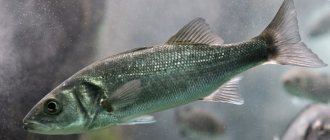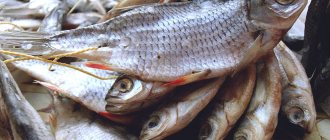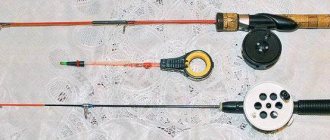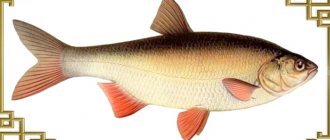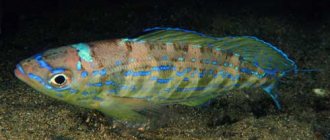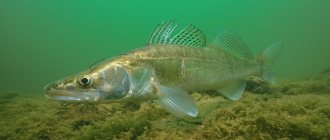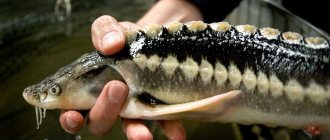Monkfish is a fish that looks like a character from a horror movie. It is otherwise called a sea anglerfish or a sea scorpion - and sometimes a fishing frog for its manner of moving along the bottom by jumping with the help of its pectoral fins.
Are you making fish pies?
- Yes 82%, 292 votes
292 votes 82%292 votes - 82% of all votes
- No 14%, 50 votes
50 votes 14%
50 votes - 14% of all votes
- I don't eat fish 3%, 12 votes
12 votes 3%
12 votes - 3% of all votes
Total votes: 354
15.01.2020
×
You or from your IP have already voted.
general characteristics
There is another name for a fish with a flashlight on its head - it is an anglerfish . This is a predator that belongs to the order of anglerfish and the class of bony fish. Lives at the bottom of the sea. It reaches two meters in length. Average weight - 20 kg. Large individuals weighing 57 kg are also known.
The body is flattened, compressed in the abdominal direction. The mouth is several times larger than the head.
The anglerfish's jaw is inactive, the mouth is several times larger than the head
A distinctive feature of the monkfish is its slightly protruding lower jaw. She is inactive. The mouth is decorated with sharp teeth that are slightly curved inward. The jaws have flexible and thin bones that allow the anglerfish to swallow large fish. There are small eyes at the top of the head.
A separate process grows from the dorsal fin. It is shifted to the upper jaw and represents a fishing rod. There is a leathery formation on it - it serves as bait and is a bag of mucus in which luminous bacteria live. The angler can turn off the light for a while so as not to attract the attention of large predators.
The habitat of deep sea flashlight fish is varied. It can be found in countries such as:
- Canada;
- USA;
- Japan;
- Korea.
Some representatives of the species are found in the waters of the Black and Yellow Seas. It can live at different depths.
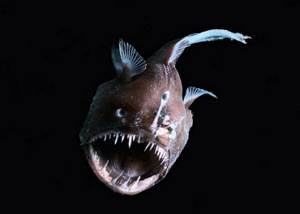
Angler fish can live at different depths
Appearance and features

Photo: What an anglerfish looks like
As already noted, the female differs from the male in the presence of a special fishing rod used to attract prey. But the differences between the sexes don’t end there; male and female anglerfish are so different that scientists used to classify them as different species. Male and female fish vary greatly in size.
The females are simply giants compared to their males. The dimensions of females can vary from 5 cm to two meters, the weight can reach up to 57 kg, and the length of males does not exceed 5 cm. These are the colossal differences in parameters! Another sexual dimorphism lies in the fact that miniature cavaliers have excellent vision and sense of smell, which they need to detect a partner.
The sizes of anglerfish vary among different species; we will describe some of them. The length of the body of the European anglerfish can reach up to two meters in length, but, on average, it does not exceed one and a half meters. The largest mass of such a large fish ranges from 55 to 57.7 kg. The body of the fish is devoid of scales; it is replaced by many leathery growths and tubercles. The body of the fish is flattened, compressed from the ridge and abdomen. The eyes are small and located quite far from each other. The fish's spine has a brown or greenish-brown tint, there is also a reddish tone, and there may be dark spots on the body.
The length of the American anglerfish ranges from 90 to 120 cm, and its weight is about 23 kg. The dimensions of the black-bellied anglerfish vary from half a meter to a meter. The length of the Western Atlantic anglerfish does not exceed 60 cm. The Cape monkfish has a huge head, which is noticeably flattened, and the fish’s tail is short. The length of this fish usually does not exceed the meter mark.
The Far Eastern anglerfish grows up to one and a half meters, its head section is very wide and flattened. Immediately noticeable is the large mouth and the lower jaw, which is pushed forward, which is equipped with one or two rows of sharp teeth. The fins located on the chest are quite wide and have a fleshy blade. On top, the fish is colored brown with spots of a lighter shade, which are framed by a dark border. The belly has a lighter shade.
Interesting fact: Sea devils move along the bottom surface using jumps, which they can make thanks to their strong pectoral fins.
In general, angler fish are simply masters of camouflage; they completely merge with the bottom, becoming practically indistinguishable from the ground. All sorts of bumps and growths on their body contribute to this. On both sides of the head, angler fish have overhanging skin in the form of a fringe, which also runs along the jaw, above the fish lips. Externally, this fringe is similar to algae swaying in the water column, because of this the fish camouflages itself even more closely with its surroundings.
Interesting fact: An anglerfish caught from the depths looks completely different from what it does at the bottom. He becomes swollen, and his eyes seem to be coming out of their sockets, the whole point is due to excess pressure, which at a depth reaches 300 atmospheres.
Main representatives of the species
Ichthyologists distinguish several varieties of anglerfish. In addition to the American monkfish, the European anglerfish is also distinguished. His body is flattened from back to belly. It grows up to two meters, its weight exceeds 20 kg. He has a huge crescent-shaped mouth. Powerful pectoral fins allow it to bury itself in the sand. The most common individuals are brown in color. Lives only in the Atlantic Ocean.
Black-bellied anglerfish are similar to their closest relatives. They have a wide head and small body size (individual length 50 cm). A characteristic feature is the wide abdominal part. Painted in gray or beige colors. There is no rod on the head.
The Burmese monkfish is distinguished by its flattened head and short tail. The length of the individual does not exceed one meter. The body is covered with leathery fringe. The lower part of the body is white, the upper part is dark.
The terrible appearance of anglerfish has given rise to a lot of superstitions. Many people believe that monkfish attack swimmers. During periods of hunger, fish rise to the top layer of water and can bite a person. At other times, the anglerfish lives on the bottom and does not collide with the drivers.
https://youtube.com/watch?v=yIP1yB6ZT40
Due to its high taste, monkfish meat has become popular, so environmentalists have proposed a ban on fishing to preserve the species. It has been illegal to harvest anglerfish in the UK since 2007.
Habitat and food
The deep-sea anglerfish lives in the waters of the World Ocean. The fish is adapted to live at depths of up to 3 kilometers. The anglerfish is especially common in the Atlantic Ocean, from the coast of Iceland to the Sea of Guinea, preferring cool waters.
Females hunt other deep-sea fish - gonostomidae, chauliodae, melamphae, and also feed on crustaceans and sometimes cephalopods.
The hunting process is as follows. The anglerfish lies on the bottom, hidden in the mud and algae. He turns on the glow of the eski and twitches it so that it looks like the movement of a small fish. To catch prey, the female patiently waits for it to swim to her. It pulls small prey into itself, sucking it in along with the water. It takes a few milliseconds to swallow a curious fish. Sometimes, using its developed pectoral fins or releasing jets of water through its gills, the anglerfish can jump forward, attacking prey.
The anglerfish is an extremely voracious fish; it can attack prey that is three times its size. Although the fish's stomach stretches to impressive sizes, such a meal ends in death for the fish. Since her teeth are curved inward, she cannot spit out her prey and gags.

Monkfish can crawl and even “jump” using their arm-like pectoral fins.
There have been cases where a species related to the anglerfish, monkfish, has swallowed seabirds with the same outcome. As a rule, the monkfish floats to the top when it eats intensively after spawning. At such moments, he can attack a person.
Males have a modest diet ; they feed on small organisms. Up to a certain point, their food consists of copepods and bristlejaws, until the males begin to parasitize.
Nutritional Features
A fish with a flashlight on its head is a predator. Therefore, its main food is other marine inhabitants. The monkfish rises to the upper layer of water, where herring and mackerel become its prey. Ichthyologists noted a case when an anglerfish attacked birds that landed on the water.
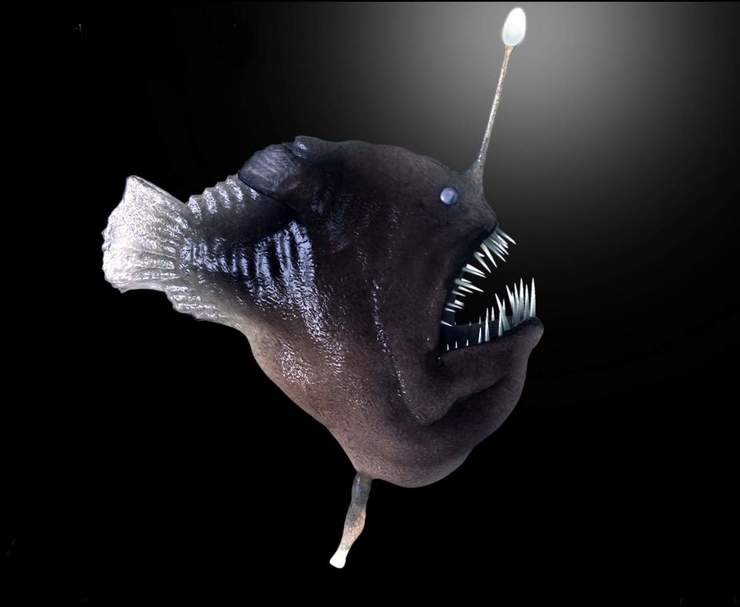
The anglerfish is a predatory fish that feeds on other types of fish.
Basic diet:
- cod or sand lance;
- stingrays;
- sharks;
- acne;
- crustaceans;
- shellfish
A fish with a lantern on its head is an ideal hunter. She can sit in ambush for hours. Natural coloring allows you to blend in with the soil or plants. The monkfish puts out its fishing rod and waits for its prey. As soon as the fish grab the bait, they immediately swallow it. A special feature of the anglerfish is the ability to hold its breath for several minutes. https://youtube.com/watch?v=FWSq6DDGcrE
Habitat

The habitat of this fish is considered to be the Atlantic Ocean. The anglerfish is found off the coast of Europe, off the coast of Iceland. In addition, monkfish have been found in the waters of the Baltic Sea, Black Sea, North Sea and Barents Sea.
The depth at which these fish usually live is from 50 to 200 meters. Most often they are found at the very bottom, because there is nothing more pleasant for monkfish than just lying quietly on sand or silt.
But it is only at first glance that the angler fish is idle. In fact, this is one of the ways of hunting. The animal freezes, waiting for its prey. And when it swims by, it grabs it and eats it.
Reproduction of anglerfish
Representatives of this species are distinguished by special reproduction. Females and males are very different from each other and ichthyologists have long considered them to be different fish. When the male reaches the age of sexual maturity, he goes in search of a life partner. A large olfactory organ and huge eyes help him in this.
Ichthyologists do not know how long the search takes. Once a female is discovered, the male latches onto her with his jaws. His tongue and lips completely grow into the bride's body. She takes him completely dependent on him and supplies him with nutrients through ingrown vessels. The male's intestines, jaws and eyes atrophy. The gills and heart work in his body - they supply the body with oxygen.
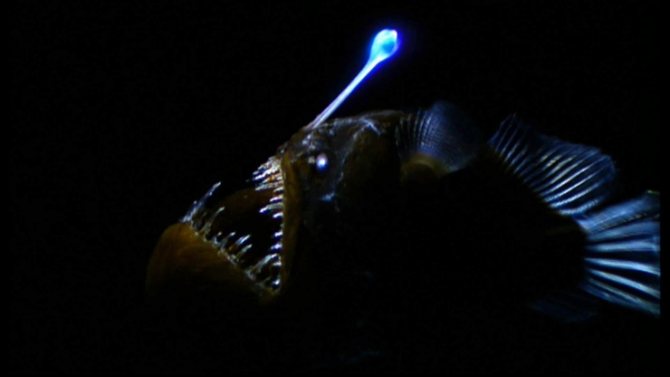
Female and male anglerfish have long been considered representatives of different species
During spawning, the female lays eggs, and the male inseminates her with milk. This happens in winter and spring. The caviar comes out in the form of a strip. Its length can reach 9 meters. Young fish switch to a bottom lifestyle when their body length is 6 cm. Before this, they live in the upper layer of water and feed on small crustaceans and fry. It is noteworthy that females can carry up to four males at a time .
Social structure and reproduction

Photo: Far Eastern monkfish
Male anglerfish are capable of breeding at different times. Some species - immediately after emerging from the tadpole form; Male European anglerfish can only breed at the age of 14 years. Females usually reach sexual maturity at 6 years of age.
European anglerfish have a spawning period, but the deepest-sea species do not spawn at all. The largest species of males fertilize eggs already spawned by the female at the spawning site - the eggs are adhesive tapes that are located in secluded places. Pisces do not look after their future offspring and leave them to their fate.
Deep-sea anglerfish reproduce in a different way. Their whole life as a male is a search for a female. They look for her by pheromones that are released at the end of her dorsal fin. When a female is found, the male monkfish needs to swim up to her from behind or from the back - so that she does not notice him. Females are indiscriminate eaters, so they can eat the male. If the male was able to swim up to the female, then he clings to her body with small teeth and clings tightly to her. After a few days, the male fuses with the female’s body, becoming her parasite. She gives him nutrients, and he constantly fertilizes her.
Interesting fact: Any number of males can join the body of a female.
After some time, the male finally fuses with it, turning into a tubercle. It does not cause any inconvenience to the female. About once a year she lays already fertilized eggs and swims away from the clutch. If she accidentally comes across her clutch again, then there is a high probability that she will eat her future offspring.
The genetic potential of males is not unlimited, so in the end they turn into a keratinized growth on the female’s body, finally ceasing to exist. The fry, emerging from the eggs, first float to the surface, where they drift along with the plankton and feed on it. Then, leaving the tadpole form, they descend to the bottom and lead a lifestyle familiar to monkfish. In total, sea devils live about 20 years, some species – up to 14-15.
Feeding
It is necessary to feed the anglerfish with live fish; it is quite difficult to accustom it to frozen food and seafood. The frequency of feeding is selected individually for each individual. Anglerfish are extremely voracious, but overfeeding is dangerous for them.
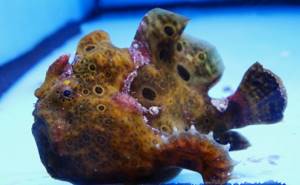
Anglerfish (Warty Clownfish) painted Antennarius pictus

